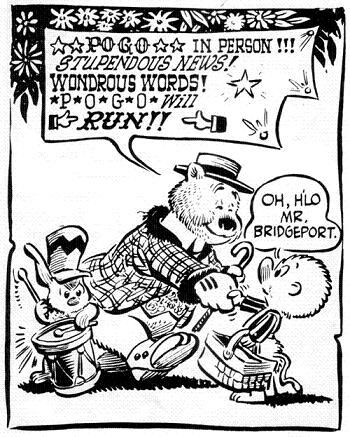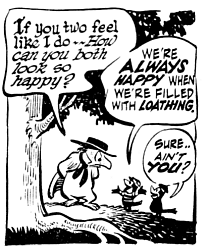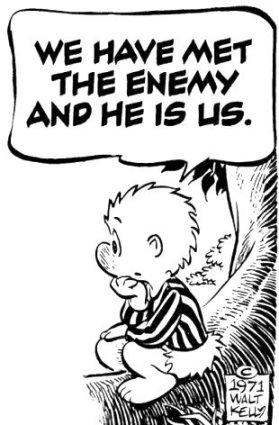I was recently reminded of a really interesting example of how animals are portrayed by the techniques of modern symbolism. The landmark political comic strip "Pogo", drawn by Walt Kelly, was extremely influential in shaping the way that the American political left viewed the events of the 1950's and 60's. "Pogo" takes place in a swamp. The animals who inhabit it usually represent prominent American figures (but, of course, the parallels are never explicit) like Joe McCarthy, Richard Nixon, and P.T. Barnum. The characters all speak in an exaggerated southern dialect, and the focus of action is held on Pogo the Possum - a figure who generally represents the wide-eyed innocence and idealism of America at the turn of the century.
The animals chosen to represent the characters in the real world usually had behaviors that Kelly considered significant. P.T. Barnum is a bear, large and excessive and bullying. JFK is an egg, who mostly just sits there and gets admired. McCarthy is a sneaky and menacing low-life bobcat. A pair of beatnik communists are cowbirds. But the parts of the characters that were the most 'animalish' were the parts that Kelly considered the most important. When the plot stops and the characters in "Pogo," however civilized, are forced to comment on the fact that some of them must eat others of them, etc. in order to survive, what we are really getting is an analogy for how difficult it is for us real human beings to escape this natural (sometimes vicious, sometimes humanizing) side.
One of the most interesting stories that we've followed through the quarter, in my humble opinion, is the development of Medieval symbolism. Symbolism for medieval scholars wasn't necessarily as straight forwards as it is for "Pogo" - this character represents that person, and this behavior represents that behavior. In Medieval art we find some of the most complex understanding of symbolism, single images meant to inspire entire worlds of meaning - a visual counterpart to Aquinas's essentialism. And what at the end of the day is the most surprising to me is just how difficult it is to think about the world like that. It is easy to feel like, to quote Pogo the Possum, "We have met the enemy and his is us." But that's what's so appealing about it all, isn't it?
I'm not sure why I'm talking about "Pogo," really. It just seems an interesting point to leave the quarter on. We've spent so much time looking at the complexities of the role played by animals in the Middle Ages that it is kind of overwhelming to try and think about drawing a coherent response (other than "I am now sure that I understand very little at all"). There is something about discussing animals that is extremely compelling. Walt Kelly thought that he wasn't merely giving his opinions on national politics - he was telling a story, and he thought that the expression of human desires through animals would let people focus in on different things in the real narrative of human affairs. Why do we express ourselves, our enemies, our Savior as animals? It may simply be that it pulls some element about human beings into the light and forces us to confront them in a way that we tend not normally to do. It often has the opposite effect of the decharacterization found in philosophical treatises - emphasizing our membership in a natural caste over the objectivity of our reason. But sometimes, especially in the Middle Ages, it seems like the stag is not really an animal at all. And sometimes it seems like it is really just a stag. And don't even get me started on dragons.
But of course, it is much, much more complicated than that.
It's been a hell of a quarter! Thanks to you all!
(and now for some "Pogo")

- B.B.




"Why do we express ourselves, our enemies, our Savior as animals?" Indeed. If there is anything that I wish we had been able to explore further this quarter, it is this question of symbolism. Why do we find animals so compelling not just to study as creatures, but to think about ourselves? I know that it has something (everything?) to do with the fact that animals have wills of their own and are emphatically not us, even the ones who have chosen (and I do think they've chosen, particularly cats, horses and dogs) to live with us. Wild animals like possums and squirrels and raccoons are even more fascinating. We have a possum living in our backyard at the moment. The dog goes out and barks at him/her/it (see previous post!) and then comes back inside (with the lure of a cookie), whereas the possum, while taking advantage of the shelter of the yard, is most certainly not "domesticated." I am rambling here, marveling at the ways thinking about animals takes us so many places (including mid-20th century political allegory) we never expected. I hope very much that you continue to think about these questions, too!
ReplyDeleteRLFB